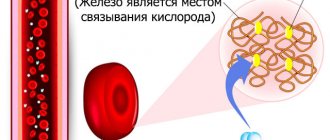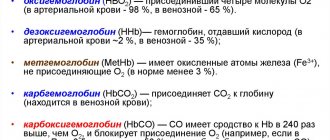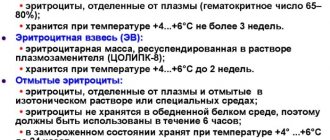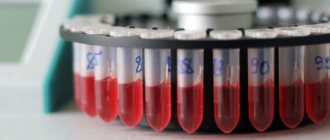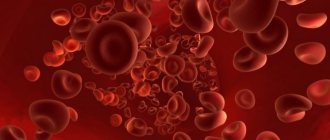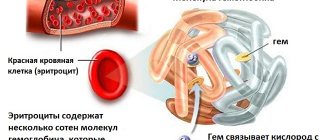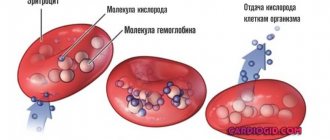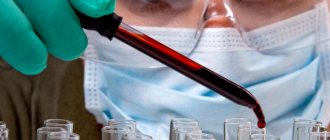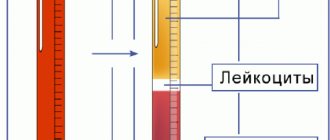A general blood test is a mandatory diagnostic procedure that every person who consults a doctor undergoes, regardless of the reason. To navigate the results of this analysis, it is important to understand what ICSU is. This indicator is an indicator and indicates the ability of the blood to perform one of its most important functions - breathing. If MSHC is elevated in a blood test, the reasons for this can lead to serious health problems.
Analysis
A complete blood count, also called a clinical test, provides information about red blood cells, white blood cells, platelets and hemoglobin. All these cells perform vital functions in the body. Hemoglobin, or Hgb, Hb is a substance of protein origin that is part of red blood cells and participates in gas exchange processes: it delivers oxygen to the cells of tissues and organs and takes CO2 from them.
The normal Hb level for adults is:
- men - 132-173 g/l;
- women - 117-155 g/l.
In children of different ages, this value varies from 90 to 150 g/l.
The amount of hemoglobin in red blood cells is a significant, but not the only index of the quality of the respiratory function of the blood. Along with it, experts evaluate the average concentration of Hb in erythrocytes (MCHC). This is an additional indicator included in a detailed blood test. Its determination requires special equipment.
MCHC in the blood should not be confused with another indicator in the analysis - MCH, which determines the amount of Hb in the red blood cell. If the first one speaks about the amount of hemoglobin in all erythrocyte cells, then the second one speaks about the Hb content in only one.
When is it recommended?
Mean erythrocyte hemoglobin concentration (MCHC) is important in confirming anemia. It is more informative than the number of red blood cells and the level of hemoglobin in the blood. With a normal or even increased content of red blood cells in the blood, the degree of their saturation with hemoglobin can be extremely low. In a detailed blood test, MSHC is necessarily present.
Also, determining this indicator is necessary in the case of:
- the presence of a constant inflammatory or infectious process in the body;
- suspicion of internal bleeding;
- suspected cancer;
- rapid fatigue.
How to prepare for analysis
Blood is a liquid medium of the body, the qualitative composition of which can change under the influence of a number of factors. In order for the analysis result to be as reliable as possible, a number of rules should be followed:
- The analysis must be carried out in laboratory conditions in compliance with all rules of asepsis and antiseptics.
- X-ray examinations are contraindicated before analysis.
- You should refrain from any physical procedures.
- Stop using medications. If this is not possible, inform your doctor.
- Limit excessive mental and physical activity.
- Refuse food and alcohol at least 10 hours before the procedure.
- Be sure to rest well before the procedure.
Important information: Norm of platelets in the blood of women by age (table)
Blood is taken from a finger in the morning.
What does MCH mean?
Having recorded picograms of MCH, it is possible to determine the content of average hemoglobin in the blood structure. Violation of permissible limits consistently leads to transformation in bone marrow cells and red blood cells. To understand what exactly provokes a change in blood composition, it is worth finding out what MSI is.
Analysis - records the hemoglobin content in the red blood cell. The final figures are calculated using the formula, dividing the total hemoglobin by the resulting volume of red blood cells.
Within acceptable limits, data is limited to 24 - 35 picograms. For children of different ages, the values may differ.
A discrepancy in MCH values occurs under the influence of various factors, which has an impact on the average blood CP value. It is the result obtained that is the basis for diagnosing anemia.
Indications for analysis
The study of material for MCH and MCHC is usually not carried out to determine only this indicator. The significance is paid attention to when undergoing laboratory blood tests, along with others.
Doctors often prescribe a complete blood count to check for MSI in patients with signs of anemia, especially in the acute period. The situation is quite serious, since loss of strength and lack of vital energy have a negative effect on the usual way of life, physical and psycho-emotional health. Sometimes it is enough to make some adjustments to the way of life, change gastronomic habits in order to positively affect the functional processes in the body.
Analysis transcript
MCHC displays the average Hb content in erythrocytes. It can be calculated using the formula: (Hgb / hematocrit) x 100.
Hematocrit is the ratio of blood cells to plasma. It is determined in any general analysis and its normal value is 39-49%.
The average hemoglobin content in red blood cells is not a constant value; it varies depending on age and environmental conditions. MSHC is elevated in infants and varies greatly throughout growth. The MCHC value in the analysis also differs between men and women.
Norm
Indicators depending on age and gender:
| Age | Norm MCHC, g/l |
| 0-2 weeks | from 280 to 350 |
| 2 weeks - 1 month | from 280 to 360 |
| 1-2 months | from 280 to 350 |
| 2-4 months | from 290 to 370 |
| 4 months - 1 year | from 320 to 370 |
| 1-3 years | from 320 to 380 |
| 3-12 years | from 320 to 370 |
12-15 years
|
|
15-18 years old
|
|
18-45 years old
|
|
45-65 years
|
|
Over 65 years old
|
|
Deviation
If a blood test shows that the average concentration of hemoglobin in a red blood cell is increased or decreased, and these deviations from the norm are large, then this may indicate a disease and requires additional examination to make a diagnosis and prescribe treatment.
Only a doctor can correctly interpret laboratory results. The MSHC assessment should be carried out in conjunction with other blood parameters: red blood cell count, Hgb, hematocrit, color index, etc.
Important information: The norm of leukocytes in the blood during pregnancy in the 2-3 trimester
How to get it back to normal?
The treatment regimen and measures aimed at stabilizing the erythrocyte index are determined by the reasons that caused this pathological condition. Hypochromia is often situational in nature and occurs after stress or heavy blood loss.
In such cases, rest and the use of sedatives are prescribed. For thalassemia, hemosorption and symptomatic correction are carried out. Specific therapy for this rare pathology has not been developed. For liver dysfunction, hepatoprotective agents are used. You need to be constantly monitored by a gastroenterologist.
In case of lead and mercury poisoning, detoxification measures are performed in a medical hospital. In each case, individual therapy is developed depending on the reasons that caused hypochromia. To clarify the diagnosis, additional examination using laboratory and hardware methods is prescribed.
Medicines
MCHC in a blood test can be reduced for several pathological reasons. In such a situation, combination drug therapy is used. Iron deficiency anemia is the easiest to treat.
Loading doses of this chemical element of 2- and 3-valence modifications are prescribed. Injectable drugs are quickly absorbed. The duration of the course and the frequency of use depend on the hematological indicator.
The body quickly recovers and begins to produce hemoglobin on its own. If hypochromia is caused by poor absorption of iron, medications are prescribed to stimulate digestive function.
The most effective drugs for eliminating anemic pathology are:
- Actoferrin, produced in capsules and saturated with sulfonated iron monohydrate, as well as serine, a non-essential amino acid that is an important component of cell membranes;
- Ferratab is an effective medicine for the treatment and prevention of iron deficiency conditions;
- Ferroplex, stimulating hematopoiesis - the formation, development and maturation of blood cells;
- Tardiferon is an antianemic drug saturated with iron atoms;
- Fenyuls is a medication that contains a multivitamin complex and improves the functioning of the hemostatic system.
If the deviation of the erythrocyte index from the norm is caused by vitamin starvation, appropriate complexes are prescribed in combination with enzyme medications.
To completely restore balance, several therapeutic courses are carried out throughout the year. In case of posthemorrhagic anemia, surgical intervention may be required to eliminate the cause of blood loss surgically.
According to the further treatment plan, iron-containing drugs and agents that affect the rheological properties of blood are prescribed. If functional liver disorders are the etiological factor for the decrease in hemoglobin in red blood cells, Karsil, Essentiale and other drugs in the category of hepatoprotectors are prescribed.
They restore the functioning of the organ and prevent further progression of the disease. For infectious infections that disrupt the hematological indicator, antibiotics, stimulators of interferon synthesis, and fungicidal drugs are used.
The choice of medications for complex therapy is determined by the composition of the pathogenic microflora. Blood transfusions and regulation of water-salt balance can restore normal hemoglobin levels.
Diet
The stabilization of MSUD can be accelerated by a competent combination of drug therapy and diet correction. Properly selected dietary nutrition will help quickly restore hemoglobin balance.
It is recommended to include apples, bell peppers, and seafood in your diet. High concentrations of iron are found in ocean fish. Citrus fruits are rich in vitamin C, which is necessary to improve the rheological properties of blood.
It is recommended to regularly consume tomatoes, beef, and cod liver. Cauliflower contains a lot of iron. Systematic consumption of walnuts, buckwheat, and peanuts is beneficial.
If the MSHC indicator in a blood test deviates from the norm in the downward direction, it is often possible to manage only with diet therapy without the use of medications. Beetroot, rosehip decoction and nutria meat will help stabilize the hematological parameter in the shortest possible time.
Why is MCHC low in a blood test?
When the saturation of red blood cells with hemoglobin is low, the MCHC indicator is reduced - this is hypochromia. It appears in many diseases of the blood and internal organs.
If the average hemoglobin concentration in red blood cells is reduced, the reasons for this may be the following:
- Iron-deficiency anemia.
- Sickle cell anemia.
- Immature forms of red blood cells.
- Damage from toxic substances.
- Blood loss.
- Hemoglobinopathies.
- Hereditary predisposition.
When the normal number of red blood cells and Hg are determined simultaneously with a decrease in MSHC, this may indicate an error made during the study, and it must be repeated.
Symptoms
Hyperchromia and hypochromia have several clinical manifestations, which are often mild or may be completely absent. In the vast majority of cases, characteristic symptoms go unnoticed due to the fact that signs of the underlying pathology come to the fore.
However, when the average hemoglobin concentration in the red blood cell is reduced, the following may occur:
- headaches and dizziness;
- weakness and fatigue;
- drowsiness expressed on a constant basis;
- increased heart rate;
- emotional instability;
- coldness of the tips of the fingers and toes;
- excessive pallor of the skin;
- deformation of the nail plates;
- increased hair loss;
- dryness and flaking of the skin;
- slight increase in temperature indicators;
- fluctuations in blood pressure;
- decreased appetite;
- problems with concentration;
- slight decrease in visual acuity.
When the average hemoglobin content in a red blood cell is increased, the symptoms are as follows:
- general weakness and weakness;
- noise in ears;
- the appearance of “flies” before the eyes;
- dizziness;
- fainting state;
- pain in the chest area;
- shortness of breath even at rest;
- aversion to food;
- weight loss;
- violation of the act of defecation - constipation;
- burning sensation in the tongue and a change in its color to bright red;
- numbness of hands and feet;
- unsteadiness of gait;
- muscle weakness;
- seizures;
- excessive irritability and nervousness;
- decrease in blood pressure.
In children and adults, the clinic will be completely identical, but the only difference may be the degree of severity of the above-described signs.
Symptoms of increased hemoglobin content in red blood cells
High level reasons
An increased value of the average Hb concentration is rare, but also indicates the occurrence of a pathological process.
MSHC can increase in both adults and children with the following pathologies and conditions:
- B12 deficiency anemia.
- Hemolytic anemia.
- Decreased thyroid function.
- Diabetes.
- Malignant tumors.
- Taking medications, such as hormonal drugs.
- Violation of water and electrolyte balance.
- Chronic oxygen starvation.
MCHC reduced
A reduced MCHC indicates a condition such as hypochromia, that is, the red cells are not sufficiently saturated with hemoglobin. This condition is associated with pathologies in which the production of iron-containing protein is impaired. Hypochromia can be caused by various types of anemia, hypovitaminosis, lead poisoning, some hereditary congenital diseases, and is also associated with a disorder of iron metabolism in the body. A decrease in the concentration of iron-containing protein in erythrocytes has the following reasons:
We advise you to read: Drugs that increase hemoglobin in the blood
- sideroblastic and hypochromic iron deficiency anemia;
- chronic posthemorrhagic anemia;
- hemoglobinopathies, in which hemoglobin synthesis is impaired and some amino acids are replaced in its chains;
- disturbance of water-electrolyte metabolism;
- thalassemia (some types) is a hereditary disease associated with mutations in genes that are responsible for the synthesis of iron-containing protein;
- megaloblastic anemia, in which red cells increase in volume more significantly than they are saturated with iron-containing protein.
When hemoglobin synthesis is impaired, MCHC decreases last. Therefore, a decrease in the concentration of iron-containing protein with normal values of other blood parameters (erythrocyte and hemoglobin content) indicates an erroneous laboratory test result.
Treatment of serious abnormalities
If an increase or decrease in the MSHC indicator is not associated with errors in the analysis, then, like any other pathological condition, this deviation must be treated. Treatment is carried out exclusively in a hospital setting.
The following will help increase low MCHC levels:
- preparations containing iron;
- vitamin B12;
- medications with folic acid.
It is necessary to eliminate bleeding, if any. The diet of such patients should be balanced and rational, containing iron and folic acid. The duration of therapy averages from 1 to 3 months.
Correction of high MSHC levels requires treatment of the underlying disease. Medicines used:
- antiplatelet agents;
- water-salt solutions;
- drugs that improve blood microcirculation.
Compliance with the diet is mandatory: exclusion from the diet of meat, liver, red foods and those containing large quantities of B vitamins and folic acid.
Sometimes treatment for these conditions requires blood transfusions or bone marrow transplants.
How is MSN calculated?
How is the average Hb content in a red blood cell calculated?
MCH is calculated by dividing the total hemoglobin (in g/L) by the total number of red blood cells (millions per microliter).
What level of MCH is normal?
The normal MCH in adults is 27 to 33 picograms per red blood cell. It should always be remembered that normal values may vary depending on the equipment of the laboratory in which the MCH is determined. Therefore, to interpret test results, you must use the standards specified by the laboratory.
Who is this analysis performed for?
The MCH is part of a complete blood count that is ordered for many reasons, from routine screening to detection of disease or toxicity.
Laboratory tests can also be used to determine whether the disease is improving or worsening, and to determine the success or failure of treatment.
For example, the MCH indicator is used in the diagnosis of hereditary spherocytosis.
What is hereditary spherocytosis?
In some people, the disease does not cause severe symptoms, and it usually goes undetected. Others have severe anemia, which may require regular blood transfusions.
Some patients need to have their spleen removed.
What is the value of MCH for diagnosing anemia?
Anemia is a decrease in the number of red blood cells and hemoglobin in the blood. According to the MCH indicator, it is divided into three groups:
- Hypochromic anemia – MCH below 26.
- Normochromic anemia – MCH in the range of 27 – 33.
- Hyperchromic anemia – MCH above 34.
What can cause an increase in MCH?
Basically, if the MCH is above 34, it is considered high. The main reason for this increase is macrocytic anemia.
This disease is often caused by a lack of vitamin B12 or folic acid in the body. An increase in MCH can also be observed during chemotherapy.
What can cause a decrease in MCH?
If the average Hb content is less than 26, it is considered to be low. MCH levels may decrease after blood loss, due to iron deficiency in the body, or microcytic anemia. Microcytic anemia is a disease in which the blood contains abnormally small red blood cells.
Also, a decrease in MCH can be caused by hemoglobinopathies, a group of diseases characterized by changes in the structure of hemoglobin.
How is the analysis carried out?
MCH is part of a routine complete blood count. After puncture of the vein, the blood is taken into a tube containing anticoagulants that prevent it from clotting. A small sample is analyzed using laboratory equipment, which is used to count the number of red blood cells and determine their size.
The amount of hemoglobin in these cells is then measured. After this, a mathematical calculation of the MCH indicator is carried out. In addition, the laboratory technician may take a blood smear, stain it, and examine it under a microscope.
He can visually assess the color of red blood cells, which is directly related to the amount of hemoglobin in each of them.
The MCH value cannot change quickly; it takes several days for the body to produce red blood cells of varying sizes. This number may change suddenly if the patient has received a blood transfusion. If no transfusion has been performed, these changes may raise suspicion of error and should be retested.
Danger
The danger of blood pathologies is that pronounced symptoms most often appear at a late stage and indicate the occurrence of complications. Conditions that you should pay attention to and do an extensive blood test:
- increased fatigue;
- pallor of the skin and mucous membranes;
- partial or complete loss of appetite;
- dyspnea;
- increased heart rate.
Finding an elevated red blood cell count and low Hgb often indicates the appearance of blast cells. Blasts are immature red blood cells; their presence in the blood indicates the development of leukemia. To clarify the diagnosis, a myelogram is prescribed.
Important information: Lifespan of leukocytes in human blood
If MSHC increases to 380 g/l or more and this result persists for a long time, there is a risk of hemoglobin hardening (crystallization) and destruction of red blood cells. Such blood is unable to perform its functions normally, which means this will lead to the development of serious complications.
Another condition in which the level of MSHC is elevated in a child or adult is called sphero- or ovalocytosis. Normally, the red blood cell has the shape of a biconcave disc, but with this disease it becomes round. Such cells are quickly destroyed, which means that the delivery of oxygen to the cells is disrupted. This anemia is a genetic disease and is treated with blood transfusions and bone marrow transplants.
If the deviation of values from the MCHC norm is not associated with such serious diseases, it still cannot be ignored. When neglected, it can lead to the following changes in the body:
- Due to prolonged oxygen deficiency, the normal functioning of the brain is disrupted with a subsequent change in its structure. These changes are often irreversible.
- Marked drop in blood pressure.
- Diseases of the heart and blood vessels.
- Disturbances in the functioning of the sense organs.
- Cramps and muscle pain.
Decoding the results of the MCNS analysis
A low MSHC rate is called hypochromia. The decoding process is carried out by a specialist who further identifies the cause of possible deviations. The most common cause is iron deficiency anemia, as there is a negative change in the process of iron absorption. Additional factors influencing a decrease in mch levels in a blood test also include:
- diagnosing a patient with a disorder of the hemoglobin protein structure of congenital etymology;
- identification of anemia, characterized by reduced iron content;
- detection of thalassemia;
- the presence of a macrocytic form of anemia.
Equally influential may be an insufficient amount of fluid, the presence of various types of inflammatory processes in the patient’s body, intoxication of the body through lead, a disorder at the genetic level and an insufficient amount of vitamins present in the body.
Very often, this kind of deviation can be accompanied by certain symptomatic signs.
The most common are the presence of tiredness and tiredness even after a long rest, a significant decrease in the overall performance of the body as a whole, constant dizziness, the presence of so-called spots before the eyes, as well as temporary loss of consciousness. All these signs directly indicate insufficient presence of iron in the human body.
Prevention
It is recommended to conduct a blood test every six months, regardless of age category and the presence of diseases. This will help you notice even minor deviations in performance in time and take appropriate measures.
You should pay attention to nutrition: it should include sufficient proteins, vitamins and minerals. In the cold season, when there is no variety of vegetables and fruits rich in nutrients, which makes it impossible to obtain enough vitamins from them, vitamin-mineral complexes and supplements should be included in the diet.
It is recommended to limit the consumption of fatty and fried foods. It is preferable to eat meat boiled or baked. It is better to avoid fast food.
In addition, it is important to lead an active lifestyle, play sports, and spend more time in the fresh air.
Low red blood cells and hemoglobin
MCHC is an indicator of the average concentration of hemoglobin in red blood cells (shows how saturated the red blood cell is with hemoglobin).
If the average hemoglobin content in a red blood cell is reduced, it means that there are certain problems with the iron content in the body, it is necessary to conduct additional diagnostics and begin treatment. MCH shows the average hemoglobin content in a red blood cell.
If the average concentration of hemoglobin in the red blood cell is reduced, then there is every reason to suspect the presence of iron deficiency anemia in the child.
- If MSHC is reduced, then the presence of hypochromic iron deficiency anemia can be suspected;
- if MSHC is elevated, it means that hyperchromic iron deficiency anemia may be observed.
If IDA is suspected in a child, to determine the hemoglobin in the red blood cell is low or normal, a general blood test is prescribed:
- In the first 3 days of a child’s life, the highest hemoglobin level should be observed: 145 to 225 g/l;
- by a month they normally decrease to 115 to 175 g/l;
- from 2 months of age to one year, the figure varies between 110 to 145 g/l.
If the average concentration of hemoglobin in red blood cells is reduced, the reasons
If the concentration of hemoglobin in the red blood cell is reduced, then the following pathologies can be suspected:
- hypochromic and microcytic anemia;
- congenital hemoglobinopathies and thalassemias;
- pathologies of porphyrin synthesis;
- lead poisoning.
If a newborn baby has a low level of hemoglobin in red blood cells, the reasons for this may be different:
- in a premature baby, the bone marrow may simply not cope with the production of new proteins;
- hemolytic disease of newborns;
- spherocytosis - irregular shape of red blood cells leads to rapid destruction of hemoglobin;
- intrauterine infection (herpes, rubella, syphilis) can also cause the destruction of red blood cells;
- Insufficient dietary intake of iron can lead to IDA, starting from the age of 6 months.
There are slightly different reasons in school-age children that the hemoglobin content in the red blood cell is reduced:
- poor diet, lack of vitamins, folic acid;
- heavy menstruation in girls;
- bleeding from hemorrhoids and gastrointestinal diseases;
- physical inactivity or, conversely, excessive physical activity.
Drugs are prescribed if the average hemoglobin concentration is reduced
If there is a low content of hemoglobin in red blood cells, medications are prescribed, treatment of which is carried out until its level increases and this status is consolidated.
To assess the effectiveness of the drug, regular blood tests are performed to check hemoglobin levels. Typically, iron supplements are taken for several months until there is visible improvement in the blood condition. but even after the laboratory parameters improve, the treatment is continued for another couple of months to stabilize the result.
Modern medicines containing iron are divided into preparations with 2-ferrous iron and 3-ferrous iron. Preparations of 2-ferrous iron in the process of reduction into 3-ferrous iron in the gastrointestinal tract form free radicals, causing all sorts of side effects: nausea, vomiting, diarrhea.
New generation drugs - ferric hydroxide complexes are devoid of such negative side effects because they do not require reduction. Such drugs are better tolerated without side effects and are much more bioavailable.
The newest ferric iron preparations are based on the polymaltose complex of ferric hydroxide. These are venofer and ferrumlek for parenteral administration, maltofer for oral administration.
Ferrumlek is injected intramuscularly, venofer is injected into a vein, maltofer is used for small children in the form of drops and syrups, maltofer foul contains folic acid, intended for teenage girls with anemia.
If red blood cells and hemoglobin are low in early childhood, long-term treatment of many months will be required. The most important requirements for drugs used in pediatrics:
- excellent bioavailability;
- undoubted safety;
- taste qualities;
- dosage forms of various types, convenient for children of all ages.
Pigment found in red blood cells
Hemoglobin (Hb) is the main pigment found in red blood cells (erythrocytes). Hemoglobin consists of 4 polypeptide chains of globin and a heme particle (iron-containing porphyrin). Heme has a high ability to bind oxygen (O2), carbon dioxide (CO2) and carbon monoxide (CO).
Hemoglobin performs a gas transport function. By binding oxygen in the lungs, hemoglobin is converted into oxyhemoglobin. Entering various tissues of the body through the bloodstream, hemoglobin enriches them with oxygen and, by binding carbon dioxide (the end product of tissue respiration), turns into carboxyhemoglobin.
Normal limits for hemoglobin content in the blood:
| Men | 130 – 160 g/l |
| Women | 120 – 140 g/l |
| Children under 1 year | 100 – 140 g/l |
| 16 years | 110 – 145 g/l |
| 6 – 16 years | 115 – 150 g/l> |
An increased level of hemoglobin in the blood occurs when
- Polycythemia
- Excessive physical exertion or agitation
- Staying at high altitude
- “Thickening” of blood (hemoconcentration) due to dehydration, burns, persistent vomiting, intestinal obstruction
- In heavy smokers due to the formation of inactive hemoglobin (HbCO)
A decreased level of hemoglobin in the blood occurs when
- Anemia
- Taking blood for analysis while lying down
- The use of drugs that provoke the development of aplastic anemia or cause the destruction of red blood cells
Hematocrit
Hematocrit (hematocrit value) is the portion of blood volume that is accounted for by red blood cells. Hematocrit reflects the volume of red blood cells, but does not take into account their number (this must be taken into account when assessing this indicator) and, along with hemoglobin and red blood cells, is used to assess the erythrocyte system.
Normal hematocrit limits:
| Adults | 35 – 54% |
| Children under 1 year | 32 – 49% |
| 1 – 16 years | 32 – 45% |
What can cause an increase in MCH?
If the average concentration of hemoglobin in the blood is increased, this may indicate the presence of mutant red blood cells in the body that are too large. This pathology can develop due to a lack of vitamin B12. In this case, there is a lack of red blood cells, but those that exist begin to mutate and increase in size. Also, MSNS in the blood test is increased for the following reasons:
- Chronic oxygen starvation. For example, living in a mountainous area or mountaineering.
- Anemia. There are few cells, but they become larger and contain a large amount of hemoglobin.
- Hypothyroidism. This disease is characterized by a decreased level of a hormone that is responsible for bone marrow activity. For this reason, the bone marrow cannot fully perform its functions, and hemoglobin accumulates in red blood cells.
- Pathological processes in the liver. With cancer and some other liver diseases, the size of red blood cells and hemoglobin increases.
- Diabetes.
- Kidney diseases.
- Heart diseases.
- Oncological diseases. Cancerous tumors negatively affect all blood parameters, including mch in a blood test.
- Lung diseases in which the level of oxygen supply is reduced.
The average hemoglobin content in a red blood cell may be increased due to the use of certain medications. The analysis may show such a deviation after taking hormonal drugs, sedatives, birth control pills or vasoconstrictor medications. If you are taking any of these medications, tell your doctor.
The average concentration of hemoglobin in a red blood cell may increase slightly throughout life.
This deviation indicates that you need to breathe more oxygen, fill your diet with vitamin foods and lead a healthy lifestyle.
Many patients do not consider elevated hemoglobin levels to be a health hazard. However, the increased hemoglobin begins to thicken and even crystallize in red blood cells, which provokes increased breakdown of red blood cells. Thus, not only the composition of the blood suffers, but the entire body as a whole.
A low concentration of hemoglobin in the blood is a condition of the human body in which the content of red blood cells in the blood decreases.
Hemoglobin is a complex iron-containing pigment consisting of iron and blood protein.
It is best to treat low hemoglobin immediately after detection of disorders.
It is important! The task of hemoglobin is to participate in the transfer of oxygen molecules to tissues and organs throughout the body by constantly capturing oxygen to the lungs, and by releasing it to all structures for the purpose of oxidative and reduction reactions. This is how the human body receives energy for life.
To establish the cause of disorders, it is necessary to clearly understand the mechanism of formation of this substance in the body.
Often a disease such as anemia occurs and it affects the deviation from the norm. Anemia is also called anemia. Average hb content in an erythrocyte: when this disease is diagnosed, often conducting methods in the form of HB tests, in this case, the level of erythrocyte substance and hemoglobin is an insufficient method.
The determination of the color index also influences. Average hemoglobin concentration in an erythrocyte MCHC: low when the average hemoglobin content in an erythrocyte. There is an increase in MCHC, and the concentration of hemoglobins in the erythrocyte increases if anemia (hyperchromic) occurs. This is in the case of ovalocytosis, folate deficiency form, B 12 deficiency form, congenital and acquired spherocytosis.
An increase also occurs in a newborn baby and this is the norm. When a study reveals an increased concentration of iron-containing proteins, this phenomenon is rare. When there is an increase in the indicator above 390 and an increase occurs, this can provoke a crystallization process in the substances.
The average hemoglobin content in an erythrocyte is reduced: with reduced detection, sometimes an erroneous option occurs. This happens due to the fact that before the examination they consumed food and alcohol. There are cases when, at an elevated level, MSHC is not associated with the fact that a disease has occurred in the body system, but means that the diagnosis revealed an inaccurate result.
When the body contains a substance that increases the level of the indicator. If there is a decrease in MSHC, this means that a condition such as a disease in the form of hypochromia is occurring in the system. This suggests that the red cell is deficient in hemoglobin substances. Such conditions occur due to pathological processes in which the performance of iron-containing protein is impaired.
MCHC is the most constant hematological coefficient, so its use is necessary so that in case of an error in the analysis, it is detected. When a disease forms in the body system, first of all, there is a disruption in the synthesis of hemoglobin substances, and the level of MSHC will decrease only at the end, when the compensatory reaction in the body has been exhausted.
The average concentration of hemoglobin in red blood cells has an increased value in the points indicated below:
- Violation of water metabolism;
- Hyperchromic anemia (folate deficiency, ovalocytosis, B12 deficiency);
- In newborns, not always, but considered normal.
A huge share of the likelihood of a significant increase in MSHC is due to negligence committed at the time of laboratory testing:
- Incorrect determination of hemoglobin and hematocrit in the blood;
- Violation of the rules for blood collection and storage, which results in incomplete decomposition of red blood cells.
These are the most common mistakes that underlie increased MSHC. But, unfortunately, there is also a small proportion in which this indicator is overestimated not due to a malfunction of the equipment, and not due to the fault of the laboratory personnel.
The only disease that increases the average concentration of hemoglobin in an erythrocyte is spherocytosis, an inherited pathology related to hemolytic anemia, it is caused by a defect in the cellular septum of erythrocytes.
Simply put, red blood cells, whose “life” and functioning period is about 120 days, due to various factors, begin to deteriorate before reaching the top point of their limit. Plus, in conditions of rapid hemolysis of the blood, the bone marrow does not have time to produce full-fledged red blood cells, which leads to a decrease in the level of such, and, as a result, a subsequent decrease in the amount of hemoglobin.
Basically, if the MCH is above 34, it is considered high. The main reason for this increase is macrocytic anemia. Macrocytic anemia is a disease of the blood system in which an insufficient number of red blood cells are produced, but each of these cells contains more hemoglobin.
If the average Hb content is less than 26, it is considered to be low. MCH levels may decrease after blood loss, due to iron deficiency in the body, or microcytic anemia. Microcytic anemia is a disease in which the blood contains abnormally small red blood cells. The smaller the size of these cells, the less hemoglobin they contain.
Microcytic anemia is often caused by iron deficiency, which may result from a lack of iron in the diet, blood loss, or impaired absorption, storage, or use in the body. Also, a decrease in MCH can be caused by hemoglobinopathies, a group of diseases characterized by changes in the structure of hemoglobin.
The concentration of hemoglobin in a red blood cell may increase in a number of the following cases:
- Against the background of hyperchromic anemia with ovalocytosis, spherocytosis, and so on.
- In the presence of disturbances in water and electrolyte metabolism.
- This indicator may increase in newborns, which is considered normal.
Increased levels of iron-containing protein are quite rare. If MCHC has increased to a value of 380 grams per liter and continues to rise, crystallization of hemoglobin may occur.
Often, when the average hemoglobin content in a red blood cell is increased, this is in no way associated with any disease, but indicates an error in laboratory testing, since high concentrations lead to a morphological change in red cells and their absolute destruction. There is only one disease in which this indicator is elevated.
We are talking about a hereditary pathology, namely spherocytosis. This condition is referred to as hemolytic anemia; it is usually characterized by a defect in the cell membranes of red cells. In most situations, the fact that the average hemoglobin content in a red blood cell is increased is due to the following technical errors:
- The procedure for incorrect determination of hemoglobin and hematocrit, including.
- Violation of the conditions for blood sampling along with its storage, in connection with which partial disintegration of red blood cells occurs.
What is hemoglobin (Hb) and what are its functions?
Hemoglobin (Hb) is a complex protein necessary for our body, which contains iron, which is found in red blood cells and in plasma in free form. Its main function is to transport oxygen to cells from the lungs and remove carbon dioxide back to the lungs.
In simple terms, red blood cells (erythrocytes) are a kind of truck that makes regular trips along the blood highway, and hemoglobin is a box in which oxygen and carbon dioxide are transported. In normal condition, one such truck should hold about 400 million boxes. Hemoglobin plays an important role in the transport of gases, but it is not the only one.
The unique chemical characteristics of hemoglobin allow you to maintain an optimal level of acid-base balance:
- Hemoglobin removes acidic compounds from cells, preventing blood and tissues from oxidizing.
- At the same time, when it enters the lungs along with carbon dioxide (HbCO2), there it prevents the blood from becoming alkalized.
But that’s not all, because methemoglobin (HbOH), which is a derivative of hemoglobin , performs another important function - binding toxic substances and hydrocyanic acid, thereby reducing the level of poisoning in the body.
What is hemoglobin and what are its functions is explained in the video:
Other reasons for deviation from the norm
Low hemoglobin is the body's natural reaction to iron deficiency. In addition to the main ones, there are several more reasons why the concentration of Hb in erythrocytes is reduced:
- Blood loss (acute or chronic). If the body is subjected to a single severe or systematic blood loss, then, as a result, the level of hemoglobin in the blood begins to decrease. This can occur due to injury, surgery, or certain pathologies. This condition is often observed in women, and the reason for the decrease in hemoglobin concentration may be polymenorrhea (heavy and prolonged menstruation). Low hemoglobin is also diagnosed in women who have had uterine fibroids, ovarian cysts or ectopic pregnancy. The reason may also be hidden in regular nosebleeds, internal bleeding, with the development of diseases of the digestive tract, and dental pathologies.
- Short lifespan of red blood cells. This factor is due to the occurrence of autoimmune diseases if the body is exposed to infection, or in the case where the decrease in red blood cells is a hereditary disease.
- Poor nutrition. The reason that the Hb content in the MCH red blood cell is reduced may be due to a lack of iron coming from organic foods. Microelements, animal proteins and vitamins do not enter the body in sufficient quantities if the patient refuses to eat meat for a long time. An unbalanced diet leads to dysfunction of the reproductive system in women and insufficient production of hormones.
- The average HB content in an MCH erythrocyte is reduced due to intoxication of the body. Anemia can develop during acute poisoning, during the presence of parasites in the body, and during frequent stressful situations.
- Blood pathologies. Destruction of red blood cells and a decrease in hemoglobin can develop as a result of blood pathologies, in the presence of malignant tumors and disorders of the bone marrow.
- Chronic diseases. In infectious diseases (enterocolitis, tuberculosis, hepatitis, pyelonephritis), a redistribution of iron occurs in the blood, which provokes a low level of hemoglobin.
- Pregnancy. A decrease in hemoglobin can occur in women during pregnancy, breastfeeding and postpartum recovery. This is due to the very intensive use of iron in the body, which is necessary to maintain vital functions.
What are the consequences of a reduced Hb concentration in an erythrocyte?
What does the indicator tell you?
MCHC, or mean corpuscular hemoglobin concentration, is one of 24 parameters determined in human blood tests. This indicator refers to the so-called erythrocyte index. The latter establishes the amount of hemoglobin in human blood and stands for the average protein concentration in the total mass of red blood cells. To carry out analyzes for the erythrocyte index, specialized equipment is used.
Hemoglobin is responsible for transporting carbon dioxide and oxygen through the bloodstream. Accordingly, MCHC demonstrates the volume of specified elements that can be moved.
However, this indicator does not indicate the amount of hemoglobin in the blood. For this purpose other tests are carried out. MCHC demonstrates the distribution density of hemoglobin throughout red blood cells.
All indices calculated during a blood test make it possible to determine the activity of red blood cells and their functional usefulness.
The danger of anemia as you age
With age, the risk of anemia increases and the consequences for life and health worsen. First of all, there is a negative effect on the heart and blood vessels. Myocardial ischemia develops, which can be complicated by a heart attack, signs of atherosclerotic diseases appear, blood vessels lose their elasticity, and plaques and blood clots form in their lumens. Due to a decrease in hemoglobin, frequent headaches, decreased attention and memory may appear. In severe situations, cerebral circulation is disrupted.
What does a decrease in the average concentration of hb in erythrocytes mchc indicate, causes and treatment
During a general blood test, the doctor will determine the main parameters and composition, which is an essential criterion in the diagnosis of many cardiovascular pathologies. In modern medicine, an important indicator in the composition of the blood is hemoglobin, which is contained in red blood cells and is denoted by the abbreviation MCH in a blood test.
What is hemoglobin responsible for in the blood?
In blood tests, MCH (hemoglobin) plays the role of the element that colors the blood red. Due to its specific structure, hemoglobin is able to bind into several elements (carbon dioxide, carbon dioxide and oxygen) found in the blood for further movement through the circulatory system to the organs.
If the average hemoglobin concentration in a particular area is decreased or increased, then the deviation is noticeable in the results of a general blood test. Typically, this parameter in the UAC is answered by the column marked MCH, although in some cases the average hemoglobin concentration may be indicated by the abbreviation MCHC.
How to determine the hemoglobin level in a red blood cell?
To determine the average Hb content in a patient’s red blood cell, you will need special medical equipment and the subject’s blood taken from the capillaries. This blood test is performed on an empty stomach in the morning, since in other cases the results of the study may be incorrect.
Taking blood from a finger to determine the level of hemoglobin in red blood cells
If the patient is on a drug course of treatment, then stop taking medications before OAC, as they can adversely affect the MSHC indicator in the blood test. Using a hematology analyzer, the doctor determines the average hemoglobin concentration and transmits the results to a specialist who makes an objective assessment. The procedure takes from 3 to 5 days.
Reasons for decrease and increase in Hb concentration in erythrocytes
If, according to the results of a general blood test, it turns out that the patient’s average concentration of hemoglobin in the red blood cell is reduced, then such a deviation indicates the presence of pathology in the body. Common diseases in which Hb in the erythrocyte is reduced are:
- Hypovitaminosis.
- Anemia.
- Toxic lead poisoning.
- Disruption of the process of hemoglobin production.
- Thalassemia (a disorder in the genes responsible for the production of iron-containing protein).
- Increase in the number of red blood cells.
- Suffered prolonged bleeding.
- Leukocytosis.
Anemia as a cause of low Hb concentration in erythrocytes
The main reasons for the decrease in the average concentration of Hb in erythrocytes lie in pathologies that contribute to disruption of the production of iron-containing protein. However, there is iron deficiency anemia, in which a low level of hemoglobin in red blood cells will not be observed.
In addition to situations where the average hemoglobin concentration in red blood cells is reduced, there may also be cases where the index deviates upward. Often, this phenomenon indicates:
- Disturbances of water-electrolyte metabolism.
- One of the types of hyperchromic anemia (spherocytosis, ovalocytosis, folate deficiency, etc.).
An increase in the average hemoglobin concentration index in erythrocytes is rare and in most cases indicates a violation during a general blood test. A similar deviation can occur in newborns, but in this case it is regarded as the norm.
Normal concentration of Hb in erythrocytes in children and adults
Hemoglobin contained in human red blood cells has its own norm, which doctors rely on when examining the patient’s blood. The indicator depends on the age of the subject and looks like this:
- At the age of 1 month to 4 years, the normal hemoglobin concentration ranges from 280 to 380 g/l.
- At the age of 5 to 14 years, the norm will fluctuate between 322 – 368 g/l.
- Over the age of 15 years, the normal hemoglobin concentration in red blood cells will be from 322 to 355 for women and from 323 to 365 g/l for men.
Up to 15 years of age, there is one hemoglobin index for both sexes; in adulthood, the index is different for males and females.
What to do if the hemoglobin concentration is disturbed?
If, according to the results of the CBC, it turns out that the patient’s MCHC is decreased or increased, then before starting to eliminate the deviation, it is imperative to find out the cause of this phenomenon. And you can do this in two ways:
- According to the characteristic symptoms of the pathology (relevant in the case when the disease is in an acute stage).
- Based on the results of additional analyses.
In most cases, it is recommended to use a diet consisting of iron-containing foods as a treatment for this condition:
- Eggs (yolk).
- Artichoke.
- Seafood (fish, shrimp, seaweed, etc.).
- Bread (whole grain).
- Poultry meat.
- Legumes.
For anemia, it is allowed to use medications that contain iron components.
If such a deviation occurs, it is better to immediately consult a doctor, since without determining the cause of the decrease in Hb in red blood cells, this phenomenon cannot be eliminated.
Source: https://lechiserdce.ru/analiz-krovi/5611-ponizhenie-sredney-kontsentratsii-hb-v-eritrotsitah-mchc-prichinyi.html
What could be the reasons?
Despite the fact that a low level of hemoglobin is called anemia, one should not mistakenly assume that this is a disease; in fact, it is a group of symptoms that are caused by various pathologies.
Despite this, several signs of anemia can be identified, which are primarily associated with a lack of oxygen in the tissues:
- sleep problems;
- pale color of mucous membranes and skin;
- dyspnea;
- increased fatigue;
- dizziness;
- weakness;
- headache.
There may be several reasons for a low hemoglobin level:
- hemolytic anemia - excessively rapid destruction of red blood cells;
- Iron deficiency anemia is a lack of microelements, vitamins, and especially iron. The cause may be poor nutrition, increased need for iron, problems with the gastrointestinal tract, hidden bleeding or chronic blood loss;
- posthemorrhagic anemia - due to severe blood loss;
- dyshematopoietic anemia - problems associated with the functioning of organs that are responsible for blood production. The cause is most often congenital pathologies, environmental problems, industrial chemistry, poisons, radiation, infections, injuries, severe nutritional deficiencies or genetic pathologies.
Important! Problems associated with hereditary or chronic pathologies and the functioning of the hematopoietic organs are the work of a professional specialist, but monitoring the prevention of iron deficiency remains the concern of any person.
The video talks about possible causes of low hemoglobin:

